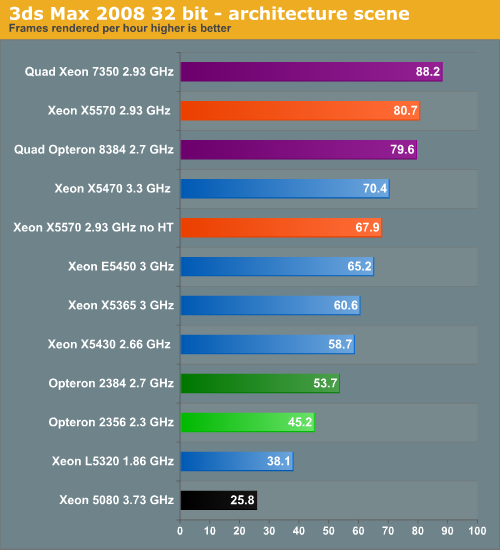The Best Server CPUs part 2: the Intel "Nehalem" Xeon X5570
by Johan De Gelas on March 30, 2009 3:00 PM EST- Posted in
- IT Computing
| Rendering: 3ds Max 2008 | |
| Operating System | Windows 2008 Enterprise RTM (64-bit) |
| Software | 3ds Max 2008 |
| Benchmark software | Build in timer |
| Typical error margin | 1-2% |
Render server are only a small part of the server market. We used the "architecture" scene included in the SPEC APC 3DS Max test. All tests were done with 3ds max's default scanline renderer, SSE enabled, and we rendered at HD 720p (1280x720) resolution. We measured the time it takes to render 10 frames (from 20 to 29) and then calculated (3600 seconds * 10 frames / time recorded) how many frames a certain CPU configuration could render in one hour. Results are reported as rendered images per hour.

We used the 32-bit version of 3ds Max 2008 on 64-bit Windows 2008 RTM. The 64-bit version of Windows 2008 is a bit slower (especially when you use the scanline renderer). All CPU configurations are dual, unless we indicate otherwise.

When it comes to floating point and SSE, the performance gains over several CPU generations are a bit smaller. The Xeon 5570 again shatters all records, but it's "only" three times faster than the Xeon 5080. There are two reasons for this. First, the Xeon 5080 is based on the Pentium 4 architecture. Thanks to its high clock speed, it can deliver relatively high FLOPS (Floating Point Operations per Second). The high branch prediction penalty, the relatively low hit rate of the trace cache, and very high memory latency which all made the Pentium 4 based Xeons very inefficient in integer code are of no real importance when running floating point intensive applications such as 3ds Max.
Improvements have been slower in this area. In the Xeon 51xx we have seen the introduction of 128-bit SSE units (AMD: Barcelona, Opteron 23xx) and faster 4-bit RADIX in the Harpertown Xeon (Xeon 54xx). We analyzed this in great detail previously: while the Opterons are still better at divisions, the Xeon 54xx is faster in multiplications which are much more common. The Xeon 55x "Nehalem" is almost identical to the Xeon 54xx "Harpertown", while the AMD "Shanghai" is identical to AMD "Barcelona" core when it comes to floating point. Notice how the Nehalem at 2.93GHz (in reality 3.1GHz) settles between the 3GHz and 3.3GHz Xeon 54xx. This confirms that floating point code hardly sees a difference between a Harpertown and a Nehalem… unless it is limited by the bandwidth available to the core of course. Nehalem can still beat its older brothers thanks to SMT, once again underlining what a powerful weapon SMT is.
While the Xeon X5570 is only 24% faster than the Xeon 5450, that is good enough to make the current 4-way servers completely useless for rendering. The dual Xeon "Nehalem" offers the same performance at much lower price points, while consuming a lot less power.










44 Comments
View All Comments
snakeoil - Monday, March 30, 2009 - link
oops it seems that hypertreading is not scaling very well too bad for inteleva2000 - Tuesday, March 31, 2009 - link
Bloody awesome results for the new 55xx series. Can't wait to see some of the larger vBulletin forums online benefiting from these monsters :)ssj4Gogeta - Monday, March 30, 2009 - link
huh?ltcommanderdata - Monday, March 30, 2009 - link
I was wondering if you got any feeling whether Hyperthreading scaled better on Nehalem than Netburst? And if so, do you think this is due to improvements made to HT itself in Nehalem, just do to Nehalem 4+1 instruction decoders and more execution units or because software is better optimized for multithreading/hyperthreading now? Maybe I'm thinking mostly desktop, but HT had kind of a hit or miss reputation in Netburst, and it'd be interesting to see if it just came before it's time.TA152H - Monday, March 30, 2009 - link
Well, for one, the Nehalem is wider than the Pentium 4, so that's a big issue there. On the negative side (with respect to HT increase, but really a positive) you have better scheduling with Nehalem, in particular, memory disambiguation. The weaker the scheduler, the better the performance increase from HT, in general.I'd say it's both. Clearly, the width of Nehalem would help a lot more than the minor tweaks. Also, you have better memory bandwidth, and in particular, a large L1 cache. I have to believe it was fairly difficult for the Pentium 4 to keep feeding two threads with such a small L1 cache, and then you have the additional L2 latency vis-a-vis the Nehalem.
So, clearly the Nehalem is much better designed for it, and I think it's equally clear software has adjusted to the reality of more computers having multiple processors.
On top of this, these are server applications they are running, not mainstream desktop apps, which might show a different profile with regards to Hyper-threading improvements.
It would have to be a combination.
JohanAnandtech - Monday, March 30, 2009 - link
The L1-cache and the way that the Pentium 4 decoded was an important (maybe even the most important) factor in the mediocre SMT performance. Whenever the trace cache missed (and it was quite small, something of the equivalent of 16 KB), the Pentium 4 had only one real decoder. This means that you have to feed two threads with one decoder. In other words, whenever you get a miss in the trace cache, HT did more bad than good in the Pentium 4. That is clearly is not the case in Nehalem with excellent decoding capabilities and larger L1.And I fully agree with your comments, although I don't think mem disambiguation has a huge impact on the "usefullness" of SMT. After all, there are lots of reasons why the ample execution resources are not fully used: branches, L2-cache misses etc.
IntelUser2000 - Tuesday, March 31, 2009 - link
Not only that, Pentium 4 had the Replay feature to try to make up for having such a long pipeline stage architecture. When Replay went wrong, it would use resources that would be hindering the 2nd thread.Core uarch has no such weaknesses.
SilentSin - Monday, March 30, 2009 - link
Wow...that's just ridiculous how much improvement was made, gg Intel. Can't wait to see how the 8-core EX's do, if this launch is any indication that will change the server landscape overnight.However, one thing I would like to see compared, or slightly modified, is the power consumption figures. Instead of an average amount of power used at idle or load, how about a total consumption figure over the length of a fixed benchmark (ie- how much power was used while running SPECint). I think that would be a good metric to illustrate very plainly how much power is saved from the greater performance with a given load. I saw the chart in the power/performance improvement on the Bottom Line page but it's not quite as digestible as or as easy to compare as a straight kW per benchmark figure would be. Perhaps give it the same time range as the slowest competing part completes the benchmark in. This would give you the ability to make a conclusion like "In the same amount of time the Opteron 8384 used to complete this benchmark, the 5570 used x watts less, and spent x seconds in idle". Since servers are rarely at 100% load at all times it would be nice to see how much faster it is and how much power it is using once it does get something to chew on.
Anyway, as usual that was an extremely well done write up, covered mostly everything I wanted to see.
7Enigma - Wednesday, April 1, 2009 - link
I think that is a very good method for determining total power consumption. Obviously this doesn't show cpu power consumption, but more importantly the overall consumption for a given unit of work.Nice thinking.
JohanAnandtech - Wednesday, April 1, 2009 - link
I am trying to hard, but I do not see the difference with our power numbers. This is the average power consumption of one CPU during 10 minutes of DVD-store OLTP activity. As readers have the performance numbers, you can perfectly calculate performance/watt or per KWh. Per server would be even better (instead of per CPU) but our servers were too different.Or am I missing something?